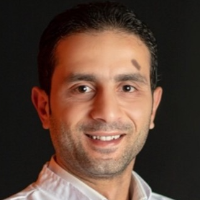Dental 2025

Mansoura University, Egypt
Abstract:
The gradual
loss of tooth enamel is a natural
outcome of the aging process.
The early depletion
of this tissue could be attributed to various factors,
such as the consumption of acidic foods and drinks,
GERD, bulimia nervosa, drug intake, and the decrease in saliva
production. The aforementioned lesions
are referred to as dental erosions and exhibit non-carious features. By using
biomimetic restorative dentistry,
which mimics the overall appearance, biomechanics, and functional properties of the normal tooth, it is possible to
restore the dentition that has been damaged. Partial coverage restorations, especially occlusal veneers
with decreased thickness, are recognized as a conservative option for restoring the loss of vertical
dimension in cases of severe occlusal erosions. Production of stronger and thinner restorations can be
fulfilled by using computer-aided design and manufacturing (CAD/CAM) technology, ceramics with high
resistance, refined bonding protocols, and durable cementation materials. The utilization of lithium disilicate ceramic restorations has become increasingly prevalent in the field of
dentistry, particularly for posterior single crowns and partial coverage
restorations. This is due to the exceptional physical properties exhibited
by these monolithic ceramic systems. A novel zirconia-reinforced lithium silicate
glass ceramic has been developed and made
available for use in dental (CAD/CAM) applications. Zirconia powder (10% by
weight) has been incorporated into the structure
in order to strengthen this new form of glass ceramic through
the mechanism of crack
interruption. This type of treatment has progressed to the point where normal sound tooth structure could be maintained while adhesion is maximized. Inter-occlusal clearance and biomechanical considerations are the primary drivers
for the tooth
preparation needed for these extra-
coronal restorations. This in-vitro study is planned to analyze the
effect of different thicknesses of ceramic occlusal
veneers and different surface
treatments on fracture resistance.
Biography:
Mansoura University in Egypt is where Dr. Maged Zahran earned his bachelor's degree in dentistry. In 2012, he graduated from Suez Canal University in Egypt with a diploma in endodontics. Then, in 2019, He get the Master's in restorative Dentistry from Mansoura University (Major operative, Major fixed prosthodontics, Major Endodontics). He has now enrolled as a doctoral student at Mansoura University's Fixed Prosthodontics Division. Ceramics, veneers, adhesives, and biomechanics are the primary areas of study. Eleven years’ experience in Ministry of Health hospitals o One year teaching Experience in restorative dentistry department, Mansoura University, Egypt o Eight years’ experience in his own dental clinic o Three months as an intern resident at Cairo University hospitals
